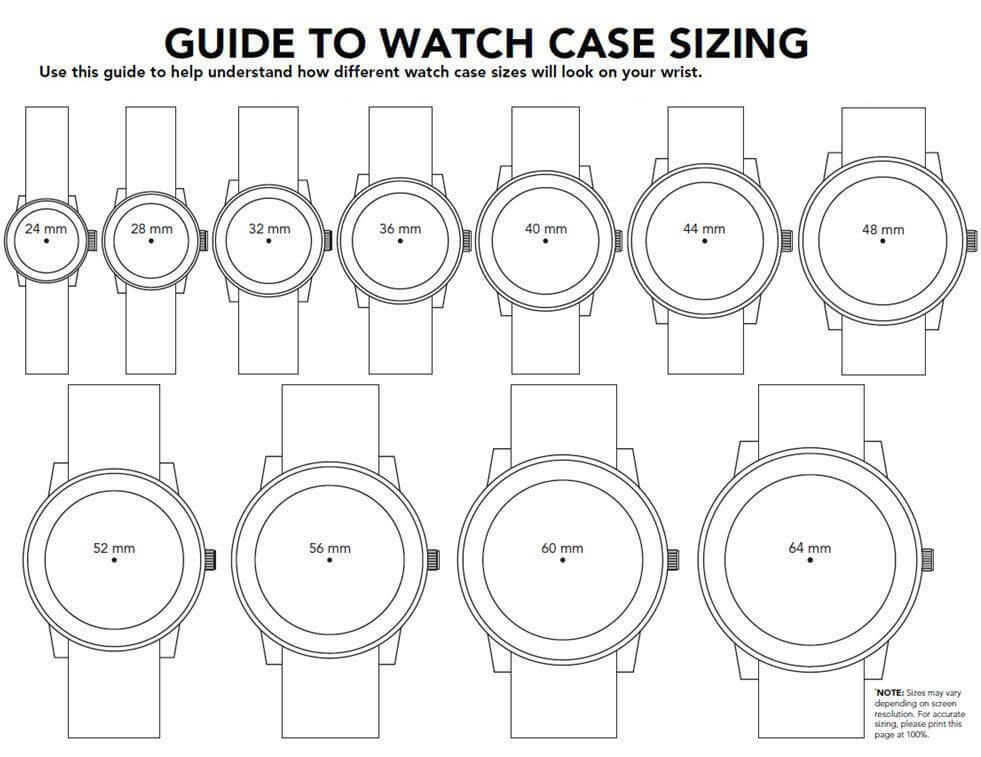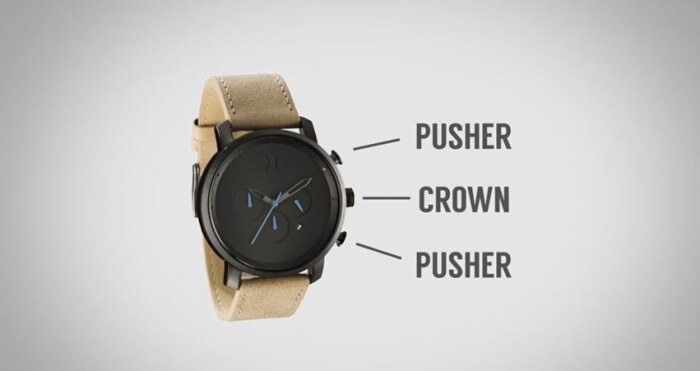Now you have to worry about which case diameter works best for you, does your wrist look good with a larger band or something thinner, are you better suited for thicker glass or a thinner casing, and what about the material of the band itself? What about a more complex style? Who knew there were so many things to consider when it comes to buying wristwatches?
Well, we did, actually, which is why we want to lay out these five rules you should follow and keep in mind the next time you’re shopping for your next watch. Before you settle on a choice, run through these guidelines to make sure it will fit your wrist size best.
Finding the Right Case Diameter
Whether your wrist is on the larger or smaller end of the spectrum, you’ll want to pay attention to the diameter of the casing. For adult sizes, you’ll typically find casing sizes ranging from 40 mm to around 56 mm, and while you may be tempted to get a larger watch face to show off your new accessory, a casing that’s too big can look, well, a little comical.
A good rule of thumb to follow is to keep the watch lugs or the two points that extend from the casing and keep the band in place, from overlapping the width of your wrist. Since these are rarely considered in the diameter of the watch, it’s best to get a visual reference of the size as some lugs can be longer than others regardless of the casing size.
When it comes to smaller watches, especially those at or below 36 mm, you can get into more feminine or even vintage territory.
What Size Casing?
Beyond even worrying about the diameter of the casing, you also will want to take into consideration the width. Generally, it’s difficult to get a wider diameter case that isn’t also incredibly thick, but you’ll likely find that “rule” being thrown out the window as watch technology is further tweaked in the near future.
When it comes to overall thickness of the case, you can find watches ranging anywhere from 6 mm all the way up to 15mm. As you probably expect, the thicker the casing is, the heavier the watch will be, which means you’re going to want to avoid a thicker watch if you have smaller wrists. You want to know that your watch is on your wrist, but it shouldn’t start to feel like a weight by the end of the day.
On the flip side of that, however, it’s difficult for a thicker wrist to sport a thinner casing without looking out of place.
Thick or Thin Bands?
Hopefully, you’re ready to do some math!
The perfect band width for your wrist actually has less to do with your wrist size and more about the diameter of the case. Regardless of whether you like a very thin or very thick band, what you’ll want is a band width that’s half the size of the case diameter. If the watch band is disproportionate to the diameter of the watch itself, the casing can either get lost against a band that’s too big or look out of place on a much thinner band.
Kind of like with the diameter of the casing, if you have a larger wrist, you’ll want a thicker band. Should you want to, you can typically replace the band and can choose between something as small as 6mm to as large as about 30mm, but keep in mind its relation to the overall diameter of the face.
While we’re on the topic of bands, don’t forget to get a band that’s sized to your wrist. A watch that flops between the edge of your hand and your upper forearm looks sloppy and one that’s too tight is just simply uncomfortable.
The Difference Between Leather and Metal
As if it weren’t difficult enough to have to chose the right size, you also need to consider the material you want your watch band to be made of. Believe it or not, the difference between leather and metal is about more than just how it looks and feels – it can greatly alter the perceived size of the watch.
If it’s a slimmer look you’re hoping to achieve, you’ll want to go for a leather band. Metal bands, however, are going to appear heavier and bulkier. Try to pair the band based on the diameter and thickness of the casing. For instance, if you have a larger diameter and thicker case, a leather band will keep it from looking too bulky(and may be harder to wear correctly for those with small wrists).
Beyond changing the perceived size of the watch, the type of band can also make your watch look either very sleek or more industrial. Thinner cases may look better with a leather band as they tend to look more sophisticated.
Looking back at sizing around the wrist, metal watch bands are easier to size should you happen to lose – or gain – any weight.
The Extra Bits
What you may not have thought of when it came to watch buying is everything beyond the band, lugs, and casing. That’s right, components like the crown, the pushers, the numbers, and the hands of the watch can actually give the illusion of a larger or smaller watch.
If you don’t have a need for larger numbers as some with poor eyesight may, you’re better off with smaller numbers, thinner hands, and fewer components. If you feel your watch is looking a little small for your wrist, you probably want to go in the opposite direction and buy one with thicker numbers and more options to it.
Of course, with the growing popularity of wearable technology, the sizing of components may wind up being a moot concern for many watch wearers as we switch to touchscreen and customizable faces.






